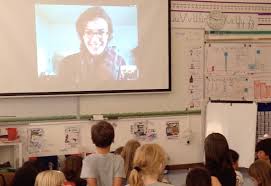Researcher + Connection =
Inspiration, Engagement & Deeper Understanding

Grade 3 students Skyping with Columbia University Grad Student Natalie R. Hofmeister
As a school leader, I love collaborating with teachers, particularly when there are opportunities to redefine students’ learning experiences.
One of my favorite ways to transform a unit is to tap into the Communication & Collaboration ISTE Standard, which is “to interact, collaborate with … experts … employing a variety of digital environments and media.”
The idea …
Last November I saw something intriguing.
Scientists had hijacked Seventeen Magazine’s Manicure Monday and were posting photos of their hands engaged in science work. As I looked through the tweets I discovered a ton of engaging, passionate scientists on twitter.
Why not try to connect them with classrooms?
What happened …
The first connection was between Abby Othman Wilson, fern researcher at the University of Hawaii at Manoa, and a grade 6 class at the Anglo-American School of Sofia.
“This was authentic and real,” said G6 science teacher Linda Dimitrov. Students wanted to know: Do you really have to record everything? and Do you have a hypothesis for every experiment that you do?
Yes!
“Why do you care about ferns?” some students wondered. Abby explained that ferns are older than dinosaurs and ferns are still here. Studying them gives us insight into possible effects of global warming.
There were two grade 6 classes. One participated with Abby and the other watched the recorded Google Hangout.
Guess which class was more engaged?
The students who asked questions with a live contact were significantly more engaged in the process.
Perhaps it’s like listening to your favorite band on iTunes vs. seeing them in concert. There’s something about a live connection that creates powerful motivation and connection.
Later in the spring, I matched COETAIL Graduate Lauren Teather‘s middle schoolers with a scientist studying kinetic energy.
She found it very helpful to clearly introduce the activity to students and have them write questions ahead of time. It also helps to be prepared if the conversation becomes too technical, she explained.
What we learned:
- A live connection is authentic and creates engagement.
- Researchers are experts in their fields and passionate about their content. This is contagious for students.
- Have students generate questions ahead of time. Categorize them and send them to the researcher prior to the connection.
- Have clear begin and end times. (A great 25 minute conversation is more rewarding than an hour in which the last 15 minutes becomes to technical for half of the group.)
- Be prepared with a back-up plan to bring the conversation back to ‘student-level’ if it gets too technical.
- The connection provides a great way to embed aspects of digital citizenship and model reaching out to experts via technology.
The present …
I’ve recently collaborated with a grade 3 teacher at my school, Christine Szeryk, to bring researchers into the classroom as part of a unit on adaptation and evolution.
We were incredibly lucky to connect with Natalie R. Hofmeister from Columbia University. She was open and a fabulous contact for our students. Natalie engaged students in a discussion about DNA and adaptation.
A week later student generated questions for our second scientist, Dr. Carla Easter of the Human Genome Research Institute. Some of the prior questions were repeated, but most of them had evolved to a new level of complexity.
When we ask students what it means to them to connect with researchers, they say it’s interesting because scientists know so much and can answer all sorts of questions.
“When we’re talking to scientists it feels like we are talking to them in real life and they are answering our questions,” said one Grade 3 student.
If you haven’t tried bringing a researcher into your classroom via technology, I encourage you to try. It’s truly wonderful for students!

Recent Comments